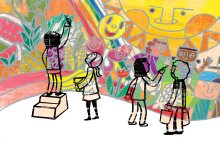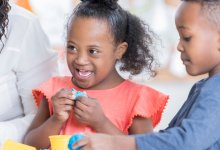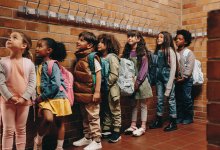Arts Integration
Bringing the arts into core curricula raises student achievement and improves student engagement. Discover and share strategies for integrating the arts throughout core subject areas.
Discovering Global Sounds Through the Recorder
Music teachers can guide exploration of musical styles from around the world to spark elementary students’ curiosity and build community.1.1kYour content has been saved!
Go to My Saved Content.Using Theater Games to Build Students’ Working Memory
By holding onto the information necessary to play certain games, students develop skills that lead to academic success.Your content has been saved!
Go to My Saved Content.Teaching Students How to Make Movies to Document Their Learning
Using moviemaking as a form of engagement and assessment centers students’ voices.Your content has been saved!
Go to My Saved Content.How Edtech Tools Can Enhance Creativity in the Elementary Grades
Teachers can guide students to explore versatile tools like Flip and Seesaw in a range of assignments across the curriculum.Your content has been saved!
Go to My Saved Content.The Powerful Effects of Drawing on Learning
The science is clear: Drawing beats out reading and writing to help students remember concepts.1.5MYour content has been saved!
Go to My Saved Content.Exploring Narrative Elements Through a Drama Game
Using an improv exercise to practice the parts of a story gets ideas flowing for students—and helps them add structure to their writing.Improv in the Classroom
A collection of our popular articles and videos about how theater games and improvisation can spark creativity, build relationships, and boost academics and executive function skills alike.115.6kYour content has been saved!
Go to My Saved Content.Building Emotional Literacy With a Brain Break
When students play a theater game where they name and act out emotions, they become more skilled at articulating their feelings.New Studies Link the Arts to Crucial Cognitive Skills
What happens to our brains ‘on art’? New studies—often backed by brain imaging technology—are beginning to dial in on the answers.328.1kYour content has been saved!
Go to My Saved Content.The Power of Multimodal Learning (in 5 Charts)
When students engage multiple senses to learn—drawing or acting out a concept, for example—they’re more likely to remember and develop a deeper understanding of the material, a large body of research shows.Setting the Tone With a Get-to-Know-You Game
Morning meeting becomes a place for kindness and gratitude with a simple but powerful community-building game.Transforming a School Through Arts Integration
Structuring a school around the arts can help students excel academically and develop social and emotional skills.270.8kYour content has been saved!
Go to My Saved Content.Boosting Preschool Students’ Language Skills Through Art and Nature
Teachers can gently embed language development into everyday sensory moments in the classroom.Bringing Math Concepts to Life Through Art and Technology
When elementary students experience math through multiple modes, they begin to see it as a language of design, rhythm, and beauty.3.3kYour content has been saved!
Go to My Saved Content.The Surprisingly Positive Effect of Drama Games on Classroom Management
Young students are more likely to remember school routines around things such as lining up if guided play is involved.












